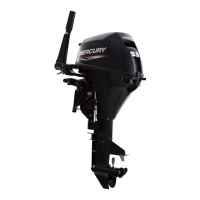90-830234R3 DECEMBER 1997 ELECTRICAL - 2B-7
If visual inspection determines that battery connec-
tions and wiring are OK, perform the following stator
and rectifier tests.
STATOR OHMS TEST
(ALTERNATOR COILS ONLY)
NOTE: Stator can be tested without removing from
engine.
1. Disconnect both yellow (stator leads) from volt-
age regulator/rectifier, or terminal block.
2. Use an ohmmeter and perform the following test.
IMPORTANT: If stator is mounted on engine,
black stator lead (if provided) must be grounded
to powerhead when testing.
3. Replace stator if readings are outside ranges
shown.
NOTE: Resistance varies greatly with temperature.
Measurements should be taken with an ambient tem-
perature range of 65 to 85 degrees F.
9 Ampere Manual Stator
Test Leads
Resistance
(Ohms)
Scale
Reading
Between Yellow Stator
Leads
0.16 - 0.19* R x 1
Between Either Yellow
Stator Lead and
Engine Ground
No Continuity R x 1000
16 Ampere Stator
Test Leads
Resistance
(Ohms)
Scale
Reading
Between Yellow Stator
Leads
0.16 - 0.19* R x 1
Between Either Yellow
Stator Lead and
Engine Ground
No Continuity R x 1000
* DC Resistance of these windings generally is less than
1.5 Ohms. If a reading resembling a short is obtained,
this would be acceptable.
ALTERNATOR SYSTEMS TEST (RED STATOR)
9 Ampere Manual Stator
IMPORTANT: Rectifier (optional accessory) must
be functioning properly for accurate test results
to be obtained.
1. Remove RED lead from (+) terminal of rectifier.
2. Connect RED (+) ammeter lead to rectifier (+) ter-
minal and BLACK (–) ammeter lead to RED recti-
fier lead.
3. With engine running at the indicated RPM, the
ammeter should indicate the following approxi-
mate amperes:
RPM AMPERES
Idle 0
Manual Stator
1000 0.6
2000 8.0
3000 9.0
4000 10.0
5000 10.5
4. If proper ampere readings are not obtained, re-
place stator.
16 Ampere Stator
1. Check battery voltage at battery with engine
running.
2. If battery voltage is above 14.5 volts, replace volt-
age regulator/rectifier. Check condition of battery
as overcharging may damage battery.
3. If battery voltage is below 14.5 volts, charge bat-
tery; refer to “Charging a Discharged Battery”,
preceding. If battery can NOT be satisfactorily
charged, replace battery.
4. If battery accepts a satisfactory charge, check
battery voltage while cranking engine; refer to
“Charging a Discharged Battery”, preceding. If
cranking voltage is not acceptable, replace battery.
5. If cranking voltage is acceptable, disconnect
larger diameter RED harness wire from starter
solenoid terminal.

